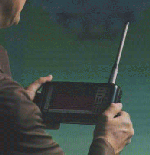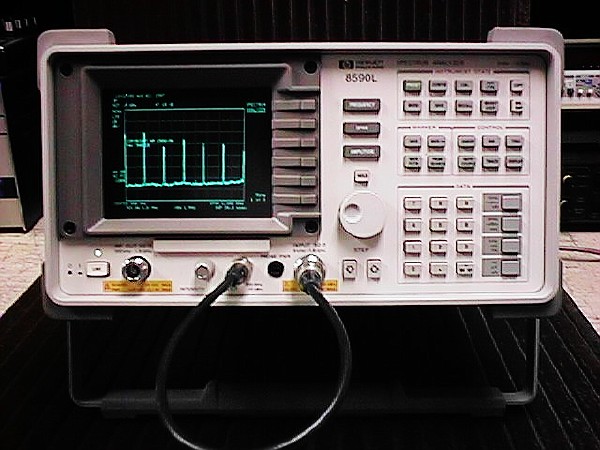 The Spectrum Analyzer:
An Explanation of Functions and Practical Applications
Definitions
The Spectrum Analyzer:
An Explanation of Functions and Practical Applications
Definitions
Audio / P.A. System
Wireless Microphones/Communications
Recently, a customer requested a "Spectrum Analyzer" to be rented along
with a large show package including video monitors, wireless microphones,
VTRs, and wireless communications. The Spectrum Analyzer that was
delivered was not the type that the customer needed. The customer
should have been more specific, however, once you read this, you as the
Account Executive, will be in a position to ask the customer for more information.
The additional information would have eliminated the confusion.
Definitions:top
Spectrum:
n.A range with defined limits containing particular items with
characteristics in common.
adj.Limiting or defining the extremes
Analyzer: n. A device used to seperate into constituent
elements so as to elucidate the interrealtion of the parts and the nature
or significance of the whole known item or group of items.
Examples of the Two Types of Spectrum
Analyzers
Audio / P.A.
System: top
The Ivie IE-30 is the industry standard,
hand held Audio Spectrum Analyzer. Bexel has these for rent. Years ago,
before technology was small enough to build something like the IE-30, acoustic
analysis came in the form of a single VU-meter device that could measure
only one frequency at a time. To analyze an entire spectrum (low to high),
single frequencies were generated by he sound system and the analyzer was
set to measure the single frequency. To generate a plot of the room, as
many as thirty frequencies were individually generated and measured. This
was very slow, and prone to error. The greatest short coming of this method
was, however, that the relationship between frequencies could not be identified
because only one frequency was ever measured at a time. When true Spectrum
Analyzers were developed, the ability to analyze all frequencies at one
time was referred to as "Real-Time-Analysis", and hence the audio industry
nomenclature of "RTA" to describe the device. RTA's use a test signal
called Pink Noise. This broad-band signal contains a collection
of many frequencies as does speech or music program material. The combination
of frequencies allows the engineer to determine how the acoustics of the
venue would effect the program material. The IE-30 kit comes with an external
noise generator. Most larger PA audio consoles have a built in noise generator.
RTA's are used to analyze "Acoustic"
energy. Acoustic energy generally comes from two sources:
(1) Ambient noise such as air-conditioning
rumble, or machinery
(2) Sound system generated energy
either as music or a calibrated test signal
In addition to analyzing the volume
of individual frequencies, the Real-Time-Analyzer can also indicate Sound-Preasure-Level
or SPL, which is used by OSHA and other monitoring organizations for industrial
and entertainment health purposes.
Wireless Microphones/Communications:top
The Hewlet Packard Spectrum Analyzer shown
above is the type that the customer required. Many of the wireless microphones
that Bexel rents are frequency agile. This means that the transmitter
can be switched to more than one carrier frequency. The details of wireless
and Radio-Frequency operation is outside the scope of this article, however,
some discussion is required to explain the use of the device.
Unlike acoustic energy, Radio
Frequency energy is NOT dependent on air for the transfer, or
propagation of the energy over distances. Likewise, an audio spectrum
analyzer uses a microphone to "sense" the measured signal, while the RF-Spectrum
Analyzer uses an antenna that is appropriate to the "range" of frequencies
to be measured. At an event or show that has a lot of frequencies in both
the VHF and UHF ranges, the analyzer gives a "picture" or display of all
the RF carriers that are active. More important, however, as the analyzer
is presenting "Actual Utilization of Available Spectrum", it indicates
which frequencies are NOT in use. These available areas are where the customer
can set the switches on the agile transmitters. Without the analyzer, it
is anyone's guess which frequencies are available. More
detail
In addition, it is important to understand
that a single frequency has artifacts called Harmonics. These harmonics
manifest themselves as additional RF energy at unique mathematically determined
frequencies. These harmonics can be on another receiver's frequency, causing
interference.
To conclude, when a customer asks for
a "spectrum analyzer", ask if it is for audio or RF purposes.
Some synonyms for the audio analyzer
are:
(1) RTA (what it does)
(2) IVIE (brand name)
(3) SPL meter (alternate use)
Some synonyms for the RF Spectrum analyzer
are:
(1) Service Monitor (a device that
includes a spectrum analyzer in addition to other tools)
(2) IFR (brand name)
top
An Introduction to Radio Frequency Dynamics
Re-printed with permission by Brad Adams, Communications
Service Engineer, The Nashville Network.
Intermodulation, or the "mixing" of two or more RF signals can be a
tremendous source of problems for the wireless engineer. When two or more
signals "mix" the by-product of this mix WILL BE the sum (f1+f2) and the
difference (f1-f2). So, for example let's say that we have two frequencies
in operation. Frequency #1 = 513.300 mHz ( a popular wireless mic frequency)
and Frequency #2 = 684.500 mHz (a common wireless intercom or wireless
mic frequency). So when these two frequencies are operating we will see
both of the fundamental frequencies (F1 & F2) and also we will see
the sum, 1,197.800 mHz and the difference, 171.200 mHz. Now let's say that
we have a wireless IFB operating on 171.200 mHz.........we have a problem!
Mixes can occur in receiver front ends, transmitter output stages and even
on a corroded screw or bolt in the metal framework of a sound stage. Our
example uses only two fundamental frequencies. In a given television production
such as an awards show, there may be as many as 50 to 60 wireless frequencies
in use! Take some time and do the math on that one! The number of mixes
that can occur increases dramatically as more frequencies are placed in
sercvice. For this reason, care must be taken to provide adequate physical
separation of wireless microphone transmitters and intercom systems and
to properly coordinate all RF frequencies in use at a given venue.



